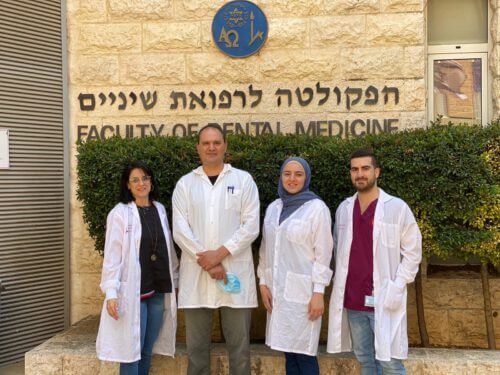About 300 million people worldwide suffer from osteoarthritis, a common disease among joint diseases, which still does not have an approved and effective drug. Will a new blood test developed following scientific research by Hebrew University researchers be able to stop the deterioration of the disease, without forcing the patients to be exposed to radiation following imaging of the joint?

Osteoarthritis is a common degenerative joint inflammatory disease, caused by injury or degenerative processes that occur throughout life. It is accompanied by processes of destruction and erosion in the joints of the body in varying degrees of severity, and is categorized as a disease of old age due to its high prevalence among the elderly population (30% of those who suffer from it are over the age of 60), although it is also common among young people who graduate from the army (due to lifting heavy loads or injuries), athletes ( whose activity includes monotonous use of a particular joint) and even among teenagers. The cartilage is used as a natural shock absorber and as a lubricant to protect the joint and the skeleton. When it wears away, it exposes the bone cortex underneath, which causes it to thicken and even cause an inter-articular connection that will limit movement in the future. The process of cartilage erosion is accompanied by intense pain, local swelling and later even to the deformation of the joint and a significant limitation of movement.
Today it is known that about 300 million people suffer from osteoarthritis in its various degrees worldwide. The disease cannot be diagnosed in its early stages, but only through advanced imaging tests such as the MRI, which can provide an accurate picture of the condition of the cartilage. The diagnostic and imaging stages take a long time due to a limitation in the availability of MRI columns, a matter that makes it even more difficult to develop a drug against the disease due to the limited window of time for investigating the early stages of the disease. Most of the patients today are mainly helped by painkillers which are recommended not to be used for a long time but in a calculated and controlled manner, so as not to cause addictions or serious side effects up to damage to the stomach, kidneys and an increase in blood pressure. A significant part of the patients will eventually need surgery to replace the joint with a titanium-based artificial prosthesis, with its major drawback being its durability, for 15-20 years.
In the Cartilage Research Laboratory of the Faculty of Dentistry at the Hebrew University, headed by Prof. Mona Dvir Ginzberg and in collaboration with Dr. Eli Reich and led by PhD students George Betshon and Jinan Elian, they have been working in recent years on the development of a diagnostic tool for degenerative joint diseases. In a new scientific publication in the prestigious journal for rheumatic diseases, "Annals of the Rheumatic Diseases", the researchers found that a unique blood test can detect the parts of the SIRT1 protein that change in the blood, and are a "biomarker" that will reveal the severity of osteoarthritis. "The opportunities for treatment of the joint disease are reduced as time passes and the joint cartilage is destroyed, which will eventually lead to a switch to the surgical option," says Prof. Dvir-Ginzberg this week. "The best means of detecting the disease in its early, asymptomatic stages is an MRI test, which is currently not readily available to every patient. The blood test we developed may reveal the stage the patients are in, identify it even in its early stages, in a window of time when experimental drugs can benefit the patient. We have information from endoscopic observations that characterize the degree of severity of the damage in the joint of humans and link the level of severity to the levels of the biomarker in the blood. Our intention is that the biomarker levels in the blood will be used as a substitute for an MRI test."
When Prof. Dvir-Ginzberg talks about experimental drugs, she means, among other things, a new and promising senolytic drug that was recently found. "With the development of the disease, cells that have undergone a process known as "senescence" accumulate, which causes a break in their ability to regenerate and divide in the joint cartilage. These cells are a kind of 'zombie' cells, which cause the death of their healthy cell neighbors. An experimental senolytic drug that is currently in the second clinical phase, is able to effectively reduce the 'zombie' cells in the damaged cartilage, prevent the death of the healthy cells and the development of the disease - this can be seen by the decrease in the blood biomarker levels. In my humble opinion, the biomarker and the drug treatment together will be able to change the lives of patients with osteoarthritis", states Prof. Dvir-Ginzberg. "This is the place to note that the research was supported by the European Union in the FP7-HEALTH DBOARD consortium and the BSF, ISF, in collaboration with research groups from the USA and Europe. The knowledge and technology commercialization company 'Yishom' from the Hebrew University has already expressed an interest in the development."
According to Prof. Dvir Ginzberg, the method of diagnosis using a blood test may later become a home test for those suffering from joint problems, to know if further treatment or follow-up with a specialist is necessary. "My dream is for patients and doctors to know better what the condition of their joint is, and when it is right to take medicine. I have no doubt that the biomarker will contribute to the development of drugs against the disease that will slow down its progress and its frequent appearance among the population in the future," concluded the researcher.

One response
For some reason, the word "radiation" was crept into the subtitle, which, as far as I know, does not exist in MRI images. I will ask for clarification.